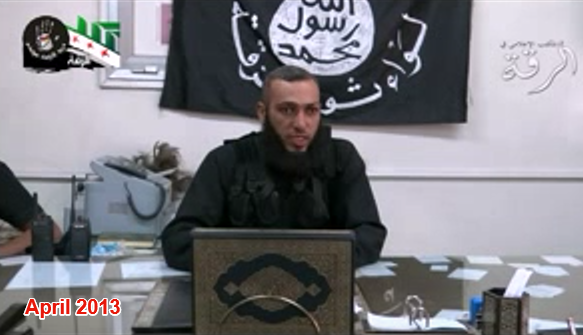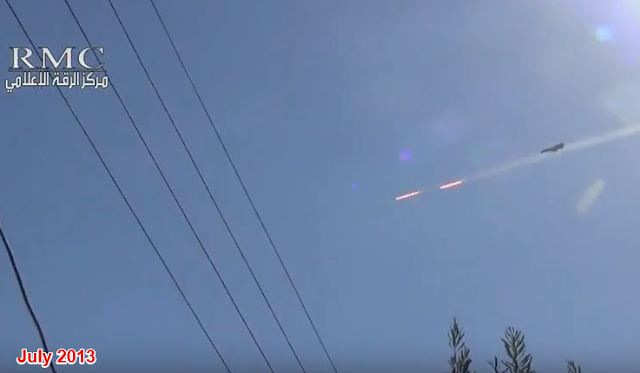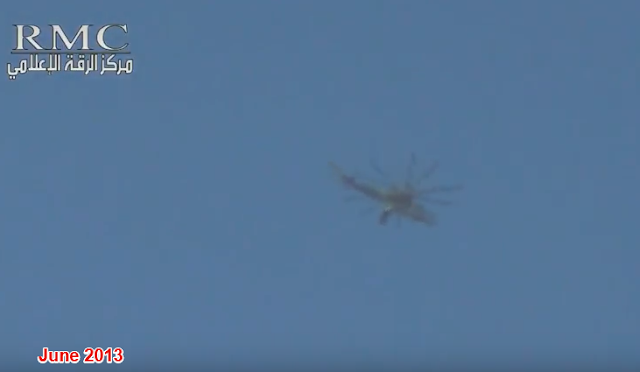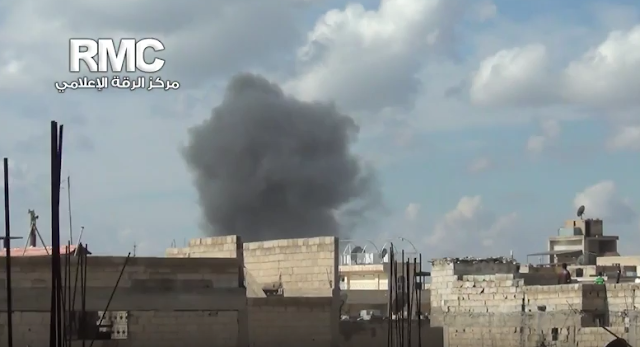The Battle of Raqqa lasted only a few days, from March 3rd to March 6th. Most of the city was under rebel control by March 5th. By March 5th the SAA controlled only a few security buildings in the Western side of the city. The remaining SAA held buildings were captured the following day on March 6th, leaving the entire city under rebel control. The SAA was now besieged in the Division 17 base to the North of Raqqa. The SAA had been taken by surprise by the rebel offensive, falsely believing that the rebels would not attempt to take the city.
Rebel numbers during the offensive measured several thousand fighters, while just 400 SAA defended the city. Jabhat Al-Nusra made up the bulk of the offensive, followed by Ahrar Al-Sham and the Free Syrian Army. ISIS also participated in the battle, though at a smaller scale.
ISIS preparing its forces just prior to the Raqqa offensive:
ISIS was more focused on governing Raqqa after it was captured. ISIS began some civil and religious administration of Raqqa by at least April 2013. ISIS had set up its headquarters in Raqqa by June 2013, and on 17th of August it temporarily suspended its assault on the besieged Division 17 base to focus completely on civil administration. This is where ISIS began to build its state.
ISIS beginning to govern Raqqa:
During the Raqqa offensive of March 3rd 2013 all the way through January 13th of 2014, ISIS and other rebel groups shared control of the city. ISIS flags appear alongside other faction's flags at protests and celebrations throughout Raqqa. Despite what many analysts say, ISIS and the "moderate rebels" were once strong allies.
While ISIS governed the city, other rebel groups attacked the last SAA outpost in the region, the Division 17 base. Being besieged, it relied on Mi-8/17 helicopters to airdrop supplies. Division 17 would only fall after ISIS reentered the fight in July of 2014. They lost 28 fighters taking Division 17.
Mi-8/17 helicopters dropping supplies into Division 17:
The SyAAF began an intense bombing campaign over Raqqa after it fell to the rebels and ISIS. It bombed some rebel targets during the battle, but most air activity took place after the city had already fallen. Many analysts say the SyAAF never targets ISIS. Video footage of the SyAAF over Raqqa disproves this. The SyAAF has been bombing Raqqa since the day it fell. Some may argue that the SyAAF was bombing other rebels too, which is not incorrect. Up until January 2014 "moderate rebels" were also present in the city. However, even after the other rebels were expelled by ISIS in January 2014, the SyAAF continued to bomb Raqqa.
Airstrikes by the SyAAF continued almost daily until Tabqa airbase was captured by ISIS on August 28, 2014. After Tabqa airbase was captured it appears airstrikes on Raqqa decreased, though they continued at a smaller scale and continue sporadically to this day. Airstrikes on the Raqqa Province increased during the SAA's offensive into the province in May of 2016.
I have compiled Images of ISIS in Raqqa, and SyAAF aircraft conducting airstrikes on the city to prove exactly two things. 1- The extent and timeline of ISIS presence in Raqqa, and 2- to prove just how active the SyAAF has been against ISIS. The images from 2013 will be presented by aircraft type, not necessarily in chronological order. Each individual image is dated.
MiG-21s were the most common jet seen over Raqqa. They dropped FAB style bombs and fired unguided rockets on Raqqa heavily in 2013.
One MiG-21 bombing Raqqa (the following two photos are from the same video.):
 MiG-21:
MiG-21:MiG-21:
MiG-21:
MiG-21:
MiG-21 firing unguided rockets:
Mi-25 attack helicopters also dropped "barrel bombs" on Raqqa:
An ATR-72 was also filmed over the city:
A nice photo:
On the 13th of January, 2014 ISIS expelled all other rebel groups from Raqqa and declared it the capitol of their caliphate. The SyAAF continued their air raids on the city. Many Analysts and self-described "experts" claim the SAA and SyAAF were working with ISIS. They ignore the previous rebel cooperation with ISIS, and seem unaware of fighting between Syrian government forces and ISIS.
The following photos are of SyAAF strikes on Raqqa after ISIS was solely in control of it in 2014. This contradicts everything western think tankers and propagandists have said.
MiG-21 low altitude bombing of Raqqa (2 photos):
Another MiG-21:
One MiG-21 crashed or was shot down during a raid:
The Su-24 also appeared over the ISIS capitol. The Su-24 is the SyAAF's most advanced aircraft. The fact that it is being used here shows the value of striking Raqqa to the SyAAF:
Various SyAAF strikes on the city:
Airstrikes continue on Raqqa to this day. Now the SyAAF, the US coalition, and the Russian airforce all strike Raqqa. As the SAA reentered the Raqqa province in May 2016, the SyAAF dropped surrender leaflets over the city. With any luck, ISIS will someday be expelled from Raqqa.

























































No comments:
Post a Comment